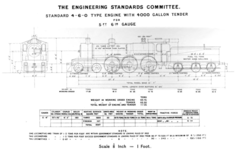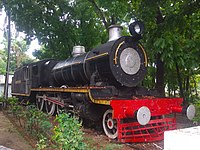Indian locomotive class HP
| BESA class HP | |||||||||||||||||||||||||||||||||||||||||||||||||||||||||||
|---|---|---|---|---|---|---|---|---|---|---|---|---|---|---|---|---|---|---|---|---|---|---|---|---|---|---|---|---|---|---|---|---|---|---|---|---|---|---|---|---|---|---|---|---|---|---|---|---|---|---|---|---|---|---|---|---|---|---|---|
 HPS 24467 on display at the National Rail Museum, New Delhi. | |||||||||||||||||||||||||||||||||||||||||||||||||||||||||||
| |||||||||||||||||||||||||||||||||||||||||||||||||||||||||||
| |||||||||||||||||||||||||||||||||||||||||||||||||||||||||||
| |||||||||||||||||||||||||||||||||||||||||||||||||||||||||||
| |||||||||||||||||||||||||||||||||||||||||||||||||||||||||||
The Class HP (Heavy Passenger) was a 4-6-0 broad gauge passenger steam locomotive introduced in 1906 on the railways of British India. It was one of the BESA locomotives developed by the British Engineering Standards Committee, later called the British Engineering Standards Association (BESA).
History
[edit]The HP class passenger locomotive was first catalogued in the BESA report on standard locomotive classes for the British Raj of 1907.[1] Like the AP class, the HP was provided with three different tenders: a small one holding 3000 gallons of water, a medium tender holding 4000, and a large tender holding 4500.
The HP class locomotives were delivered to various railways, but only the Indian States Railways (ISR)-operated railways referred to them as the HP class. They were built by several British locomotive manufacturers, including the Vulcan Foundry, Robert Stephenson and Company, North British Locomotive Company, Kitson and Company and William Beardmore and Company.[2]
A later, superheated version was fitted with a Schmidt superheater and classified as HPS (the S means superheated). Retrofitted HPs with superheaters were classified as HPC (the C means converted).[3]
-
Variant with 3000 gallon tender
-
Variant with 4000 gallon tender
-
Variant with 4500 gallon tender
Design
[edit]The locomotives were designed with two cylinders, a Belpaire firebox, and used saturated steam. The grate was arranged between the two rear coupled wheelsets, which had their wheel base lengths increased to accommodate the grate. The cylinders were fitted on the outside and the motion was driven from the second driving wheel. The saturated HPs were fitted with Walschaerts valve gear with slide valves; piston valves were used in the HPS and HPC classes. The running board was positioned low, so splashers had to be fitted above the driving wheels. As with the AP class locomotives, the cab running board is positioned to match the height of the tender running board, and the cab running board also arcs up to the locomotive running board. A small pilot was attached to the front buffer beam. The driver's cab was completely enclosed with a half-cab on the tender. The tender was equipped with running boards and handrails along the side walls, which made it possible to reach the train from the locomotive while running.[4]
Preservation
[edit]Three HPS class locomotives have been preserved:
- Bangladesh Railway HPS 30 in Rajshahi[5]
- Indian Railways HPS 32 at the Rail Museum, Howrah
- Indian Railways HPS 24467 at the National Rail Museum of India, New Delhi.[6]
| Working | Class | Number | Location | Built | Zone | Builders | Build No | Name |
|---|---|---|---|---|---|---|---|---|
| No | HPS | 30 | Rajshahi Railway HQ | |||||
| No | HPS | 32 | Regional Rail Museum Howrah | ER | ||||
| No | HPS | 24467 | National Rail Museum | 1950 | RB | Vulcan Foundry Ltd, Newton Le Willows |
-
Preserved Bangladesh Railway HPS
-
Preserved HPS in the National Rail Museum of India
References
[edit]- ^ Second report of the Locomotive committee on standard locomotives for Indian railways. February 1907. pp. 4–5. Retrieved August 31, 2024.
- ^ Llanso, Steve. "Great Indian Peninsula 4-6-0 Locomotives in India". SteamLocomotive.com. Sweat House Media. Retrieved August 31, 2020.
- ^ Hughes 1979, p. 18.
- ^ J. Stuart (1907). "North British Locomotive Company Glasgow (NBL) L294, Indian State Railway (ISR)-East Bengal Railway 234" (in German). Zurich: ETH Library. Retrieved August 31, 2020.
- ^ Schneider, Torsten. "Preserved Steam Locomotives in Bangladesh". International Steam Pages. Retrieved August 28, 2017.
- ^ Hughes 1979, p. 91.
- Hughes, Hugh (1979). Steam Locomotives in India, Part 3 - Broad Gauge. The Continental Railway Circle. ISBN 0950346942.









